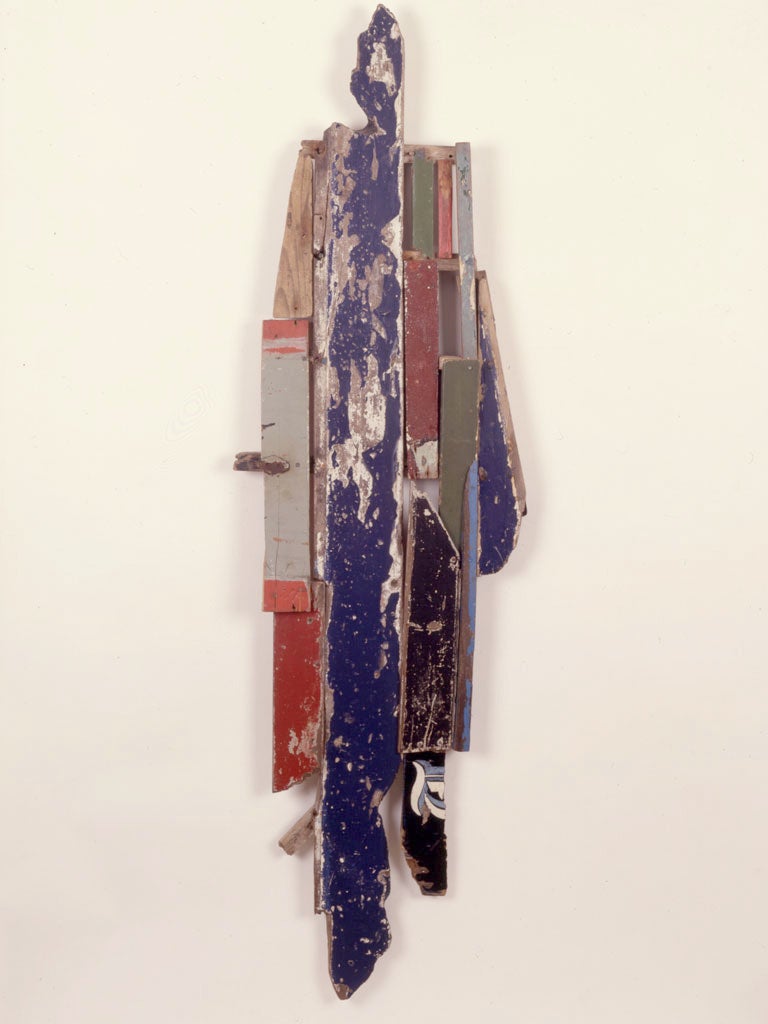Bog Man, 1990, by Margaret Mellis
Estate of the Artist

Artists of the 20th century were much preoccupied by the idea of the found object. When Marcel Duchamp, that sublime prankster, placed a urinal on a museum wall, he was concerned, in part at least, to make a gesture expressive of his hatred of the idea of the museum itself, to spit on those soaringly forbidding cultural walls. When the Surrealists seized hold of found objects for the purpose of art-making, they sang of the marvels of the aleatory impulse, the desire that art should emerge out of some chance encounter, like an act of brilliant prestidigitation – as one would meet a lover or a murderer.
Found objects can be curious things though. The very fact that they have been chanced upon and not made means that you could argue that they are unauthored. That idea would have appealed to many of those Modernist successors of Victorian traditions of narrative painting who abhorred the idea of art having authorial designs upon us – pointing up some sentimental moral, for example.
Found objects with a life to come arrive on the doorsteps of artists who possess an appetite for such things, calling out to them subliminally. That is a part of their mysterious appeal. During the last 30 or so years of her life, the artist Margaret Mellis, Scots by birth, English by adoption, kept a very close eye on the beach at Southwold in Suffolk, looking out for promising bits of driftwood.
It is no longer possible to do such a thing now. The groynes now repel the stuff. Only the delights of plastic drift in these days. Mellis would comb the shoreline, gathering her bits and pieces of driftwood serendipitously, and then store them in her studio inside the house, or stack them beside her front door in untidy heaps in order to annoy her neighbours. Sometimes, as with the bits of detritus that hang around many sculptors' studios, these bits of driftwood waited years for attention. Exactly the same thing is to be observed in the studio of Anthony Caro in north London, things large and small – wood, steel, rope – hanging around, waiting for their moment in the sun.
The point about a found object is that it is more than likely to look unlovely and unpromising – that is the very nature of its appeal. It will probably not exist for the sake of itself alone. It lives to exist in conjunction with other pieces of a similar provenance.
Few individual pieces would have looked more unpromising to the incurious eye than the elements of wood that form the elements that finally merged into the Bog Man on this page. Mellis has created an assemblage here, screwing thin, individual bits together, all so long and attenuated and almost ravaged looking, like some parched, blistered, battered saint in his tatterdemalion robes of office.
The figure itself looks terribly weak, deprived, suffering, husk-like, far beyond the reach of any living impulse. It is a sacred relic. Such is its thinness that it seems to be rising up out of itself, heavenward, mouthing mute hosannas, as if its very spare, ravaged look has made it a privileged spiritual onlooker.
None of these individual pieces of wood have been newly painted by the artist. Such bits of paint as exists on this piece at all were there already. They are barely present at all in places, merely sad, discontinuous patches. What is more, we can, to an extent, see right through him. He is present, suspended here by his own somewhat skeletal armature. The wash of the tide, the relentless grittiness of the sand, have scoured him back to this almost touching degree of visual impoverishment. And yet this bog man is wonderful precisely because he has been scarified to this degree. If he were less imperfect, less pummelled by circumstance, he would be far less magnificent in his strange, ghostly decrepitude.
About the artist: Margaret Mellis (1914-2009)
Margaret Mellis was a painter, collagist and sculptor. Her later works divides between wooden constructions and paintings, which she often made on the backs of opened out envelopes. Though Scottish by birth, her work is strongly identified with the county of Suffolk, where she lived for much of her later life.
Join our commenting forum
Join thought-provoking conversations, follow other Independent readers and see their replies
Comments